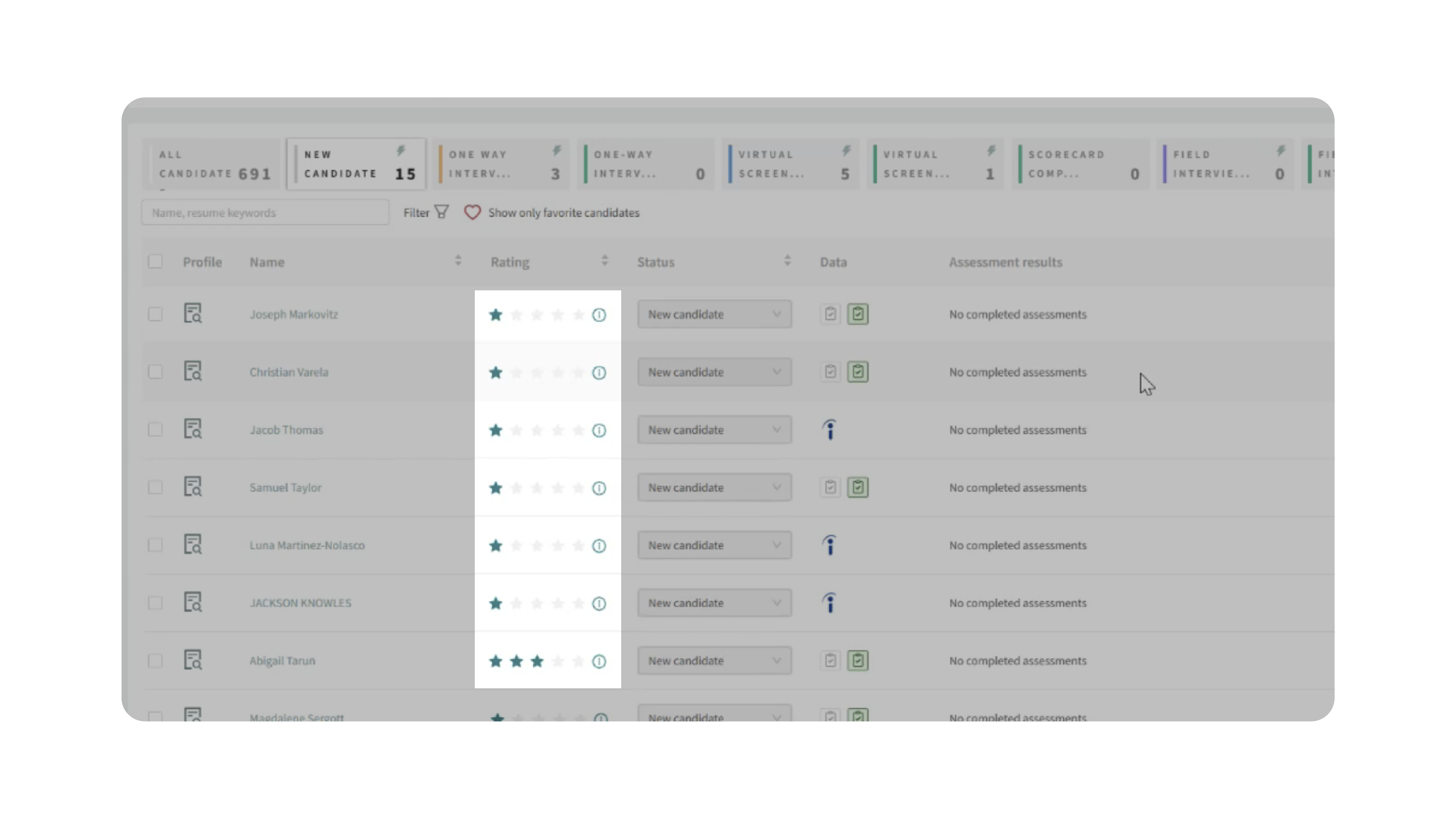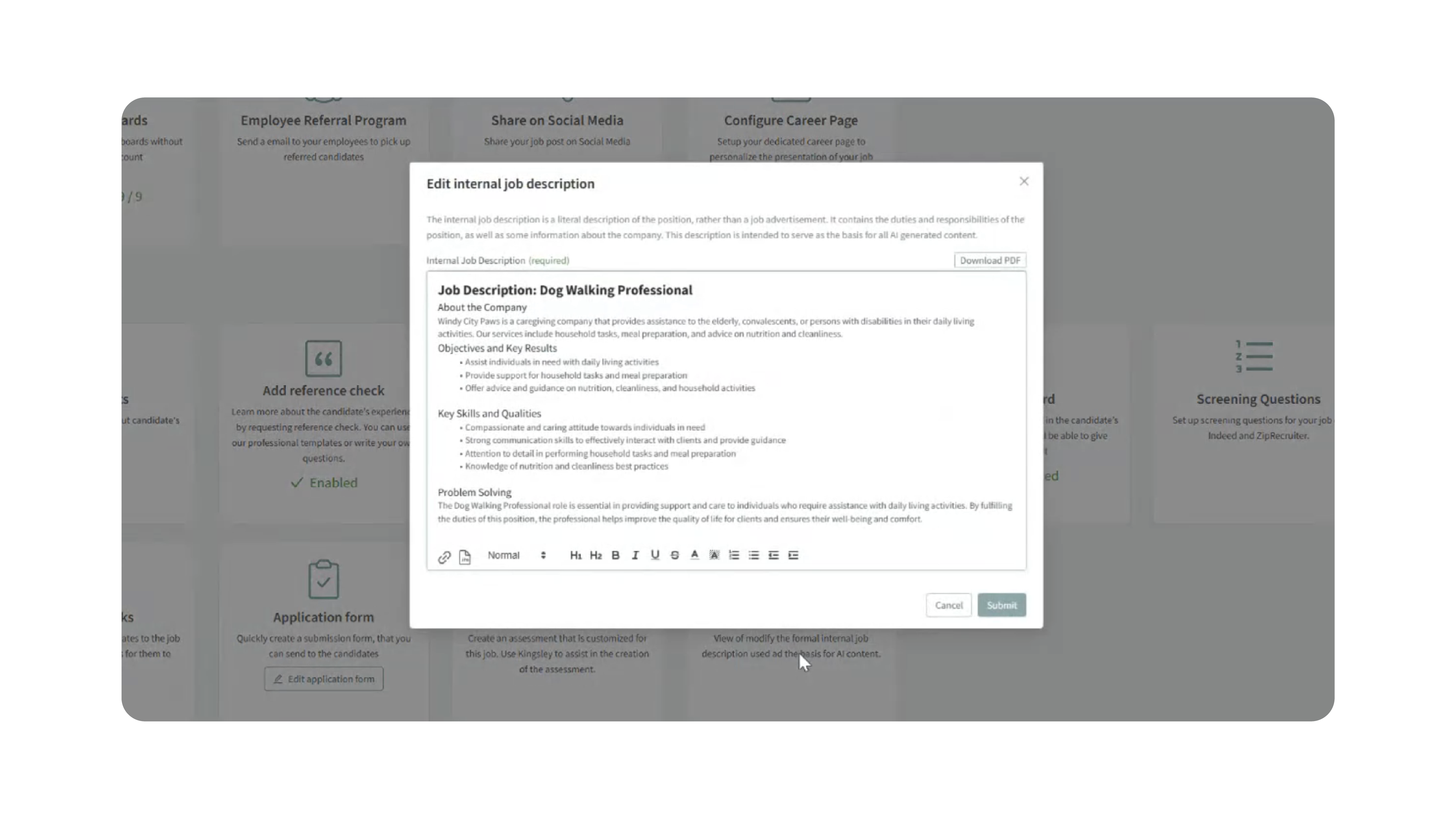Evaluating Resumes with AI Insights
Overview
Evaluating Resumes with AI Insights in Discovered uses Kingsley, a custom-trained version of ChatGPT, to help you quickly star-rank candidates based on their resumes. Kingsley is trained on real user behavior—especially how recruiters and hiring managers star-rate candidates—so over time it learns what “great,” “average,” and “poor” fits look like for different roles.
Kingsley works best when roles have clear, must-have attributes (e.g., CPA license, Juris Doctorate, specific engineering degrees, defined technical skills). For more ambiguous roles (like “dog walker” or roles with softer, less structured criteria), Kingsley still helps, but it’s most powerful when you clearly define what a great candidate looks like.
You can improve Kingsley’s accuracy by:
- Defining clear evaluation criteria (what you look for in a 5-star candidate).
- Creating a strong internal job description/prompt that captures these criteria.
- Consistently star-rating candidates, so Kingsley continues to learn from your decisions.
How to Evaluate Resumes with AI Insights:
1. Understand How Kingsley Evaluates Resumes:
Kingsley uses multiple inputs to evaluate candidates:
- A custom-trained AI model based on user star ratings in Discovered.
- The job description and internal criteria you’ve defined.
- The candidate’s resume content, compared against those criteria.
It then assigns a star rating (1–5) to indicate how strong of a match each candidate is for that job.

2. Define What a “Great” Candidate Looks Like:
Before relying heavily on AI scoring, clarify your own mental checklist:
- Look at candidates you’ve hired or highly rated in the past.
- Ask yourself:
- What makes them a 5-star candidate?
- Which degrees, certifications, or skills are non-negotiable?
- What experiences or achievements are strong signals?
Think of it as if you were training a new intern to review resumes—you’re trying to make your instincts explicit and repeatable.
3. Use the Hiring Expert Prompt (Internal Job Description):
To help Kingsley evaluate resumes more accurately, you can craft a performance-based internal job description and scoring prompt.
A typical workflow:
- Start from your existing job ad or job description.
- Use the “hiring expert” guidance
- Refine the prompt by adding: Which attributes are required vs. preferred. How you want candidates scored on a 1–5 star scale. Any red flags that should lower a candidate’s score.

Once you’re satisfied, paste this refined internal description/prompt into the internal job description / AI prompt area for that job (e.g., within the Find & Evaluate Talent section).

4. Let Kingsley Evaluate Resumes:
After your criteria and internal description are in place:
- Add or import candidates to the job as usual.
- Kingsley will process resumes and assign star ratings based on the internal job description/prompt you provided. The job requirements. Resume content and alignment with your defined attributes.
- In the job’s candidate list, review the AI-generated star ratings to quickly identify top candidates.
Remember: Kingsley is assistive, not a final decision-maker. You should still open resumes and verify the AI’s reasoning, especially for borderline or high-impact decisions.
5. Refine and Train the System:
You can keep improving Kingsley’s performance over time:
- Star-rate candidates yourself.
- Continue rating candidates manually (1–5 stars) based on your professional judgment.
- These ratings become training data that help Kingsley understand what you consider strong vs. weak fits.
- Adjust your internal prompt.
- If Kingsley over- or under-values certain traits, update your internal job description/prompt.
- Add clarifying instructions like:
- “Favor candidates with X certification.”
- “Strongly prefer Y experience; candidates without this should rarely receive 4–5 stars.”
- “Do not penalize candidates for Z if they meet all other criteria.”
- Re-run for future candidates
- As new candidates apply, Kingsley uses your updated criteria and its improved understanding to provide better star ratings.
Why This Matters
Evaluating resumes with Kingsley’s AI insights helps you:
- Save time: Quickly surface top candidates from large applicant pools.
- Add consistency: Apply the same criteria across all candidates, reducing subjective variability.
- Leverage your expertise at scale: By encoding your personal checklist into prompts and ratings, you teach the AI to think more like your best recruiters.
- Improve over time: As you star-rate candidates and refine prompts, Kingsley’s recommendations become more aligned with your preferences and hiring standards.
This doesn’t replace human judgment—it amplifies it.
Use Cases
- High-Volume Roles: Quickly triage hundreds of resumes for entry-level or high-volume positions.
- Certification-Heavy Roles: Roles requiring clear credentials (CPA, JD, RN, specific engineering degrees).
- Specialized Positions: Use performance-based prompts to highlight must-have technologies, tools, or domain experience.
- Internal Experiments: Compare how AI ratings align with your team’s ratings to calibrate and improve your prompts.
Best Practices
- Be specific, not vague:
- “3+ years B2B SaaS sales” is better than “sales experience.”
- “Has worked with QuickBooks or NetSuite” is better than “accounting systems experience.”
- Start with clear-cut roles:
- Kingsley performs best where there are obvious must-haves (licenses, degrees, tools, years of experience).
- Iterate on your prompt:
- Treat your internal job description as a living document. Adjust it as you learn what Kingsley gets right or wrong.
- Keep star-rating candidates:
- The more you rate, the more Kingsley learns what a 5-star vs. 2-star candidate looks like in your context.
- Use AI as a first pass, not a final verdict:
- Always validate AI rankings with human review, especially for critical roles or atypical candidate backgrounds.
What Happens Next
Once you start using Evaluating Resumes with AI Insights:
- Kingsley begins assigning star ratings to candidates based on your prompts and past data.
- You review candidates, adjust star ratings, and refine internal job descriptions as needed.
- Over time, Kingsley becomes more accurate for your roles, helping you spend less time sorting resumes and more time engaging with high-potential candidates.
- You can continue to experiment with different prompt variations and evaluation criteria to see which setup best matches your team’s decisions.
With a thoughtful setup and ongoing feedback, Kingsley becomes a powerful partner in screening resumes—turning your expertise into a scalable, AI-assisted resume evaluation process.
